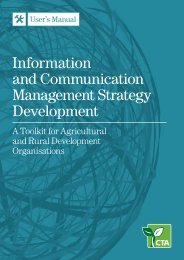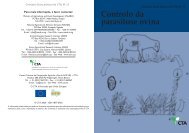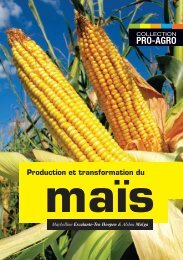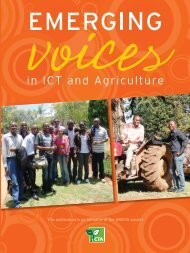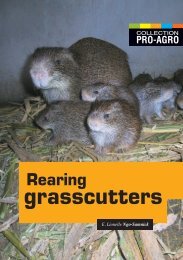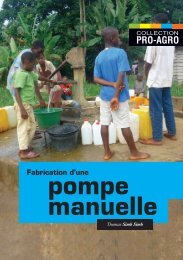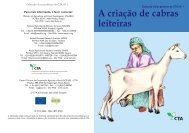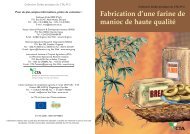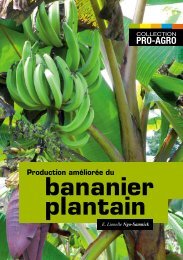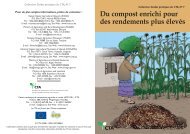Policy framework for Pastoralism in Africa
Policy framework for Pastoralism in Africa
Policy framework for Pastoralism in Africa
- No tags were found...
You also want an ePaper? Increase the reach of your titles
YUMPU automatically turns print PDFs into web optimized ePapers that Google loves.
many <strong>Africa</strong>n countries have already made considerable advances <strong>in</strong> terms of support<strong>in</strong>g alternativeanimal health delivery systems with pastoralists, especially systems which l<strong>in</strong>k community-basedanimal health workers to higher levels of para-veter<strong>in</strong>arians and veter<strong>in</strong>ary professionals. There isalso <strong>in</strong>creas<strong>in</strong>g support to the private sector provision of cl<strong>in</strong>ical services, under the regulation andsupervision of national veter<strong>in</strong>ary services. All of these approaches are supported by the <strong>in</strong>ternationalstandards of the World Animal Health Organization (Office <strong>in</strong>ternational des epizooties)and AU/DREA. Some <strong>Africa</strong>n countries have also revised veter<strong>in</strong>ary legislation as a means to <strong>for</strong>malizeand regulate privatized, CAHW-type systems <strong>in</strong> pastoral areas. There is now a need <strong>for</strong>further support to these systems to ensure wider application <strong>in</strong> pastoral areas, and stronger l<strong>in</strong>ksto national livestock disease surveillance systems.b) Risk-based disaster managementThe pr<strong>in</strong>ciples of risk-based drought management are widely known <strong>in</strong> <strong>Africa</strong>. Drought is a slowonsetdisaster and although the exact tim<strong>in</strong>g of drought cannot be predicted, with<strong>in</strong> a given period(e.g. five years) it can be predicted that a major drought will occur at least once. There<strong>for</strong>e, droughtis both expected with<strong>in</strong> a given timeframe, and when it occurs, allows sufficient time <strong>for</strong> detectionand early response.Evaluations of early drought responses <strong>in</strong> pastoral areas of <strong>Africa</strong> have demonstrated the economicrationale <strong>for</strong> work<strong>in</strong>g with pastoralists to protect core livestock assets dur<strong>in</strong>g drought. Pastoralistsrarely aim to protect all livestock when drought occurs, but focus on the ma<strong>in</strong>tenance of adultbreed<strong>in</strong>g stock with a view to maximiz<strong>in</strong>g post-drought recovery. Early market-based <strong>in</strong>terventionssuch as commercial destock<strong>in</strong>g with private sector partners, comb<strong>in</strong>ed with supplementary feed<strong>in</strong>gof selected breed<strong>in</strong>g stock, have been highly effective. These approaches are supported by <strong>in</strong>ternationalguidel<strong>in</strong>es and standards <strong>for</strong> emergency livestock projects, and <strong>in</strong> some countries, nationaldrought management guidel<strong>in</strong>es.However, livelihoods-based drought cycle management has yet to be fully <strong>in</strong>stitutionalized <strong>in</strong> most<strong>Africa</strong>n countries whereas <strong>in</strong> contrast, food aid is <strong>in</strong>stitutionalized and there<strong>for</strong>e, the standardresponse to drought. Strategy 2.3 <strong>in</strong>cludes the need to re-align disaster management policies towardsrisk-based, livelihoods approaches and early response <strong>in</strong> pastoral area, rather than wait<strong>in</strong>g <strong>for</strong>livelihoods crises to evolve, and then deliver<strong>in</strong>g food aid.Strategy 2.4 Market<strong>in</strong>g of pastoral livestock and livestock productsThe market<strong>in</strong>g of pastoral livestock and livestock products takes place at three levels: domestic,regional (<strong>in</strong>clud<strong>in</strong>g cross-border trade), and <strong>in</strong>ternational. Some constra<strong>in</strong>ts to market access canbe common across all three broad market categories, whereas other constra<strong>in</strong>ts are specific to thetype of market. For example, excessive taxation is a common constra<strong>in</strong>t, whereas <strong>in</strong>ternationalstandards and related challenges apply ma<strong>in</strong>ly to access to <strong>in</strong>ternational markets. Each type ofmarket also has advantages and disadvantages, with high value markets <strong>in</strong> terms of <strong>for</strong>eign exchangebe<strong>in</strong>g relatively high risk and high cost, compared to lower value domestic markets which carrylower risks. There are also area-specific variations <strong>in</strong> constra<strong>in</strong>ts and options, and many constra<strong>in</strong>tsare not specific to the livestock sector e.g. the availability of air freight to transport chilled meatwith<strong>in</strong> <strong>Africa</strong>. It follows that ef<strong>for</strong>ts to improve the market<strong>in</strong>g of livestock and livestock productsrequire economic and market analysis, <strong>in</strong>clud<strong>in</strong>g comparative analysis of the different marketSecur<strong>in</strong>g, Protect<strong>in</strong>g and Improv<strong>in</strong>g the Lives, Livelihoods and Rights of Pastoralist Communities39




